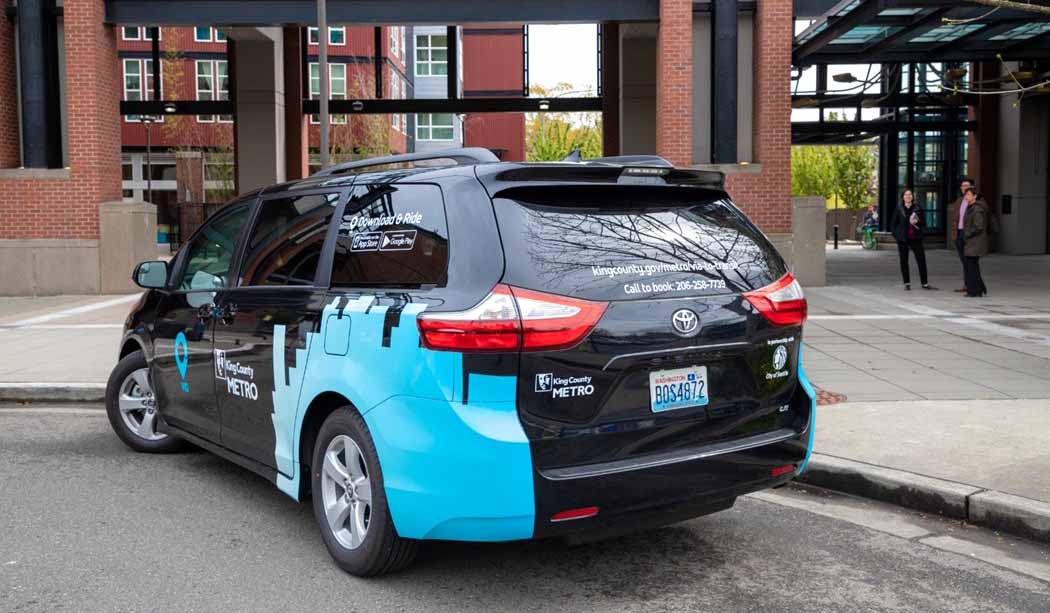This project demonstrated the viability of a public agency partnership with a private sector transportation network company and evaluated the results of providing on-demand, first-mile/last-mile access to transit services.
Sound Transit and King County Metro teamed with Los Angeles Metro on the evaluation, which was conducted by the Washington State Transportation Center working with the Eno Center for Transportation. The Via to Transit pilot project was intended to test how public agencies can develop a partnership with a private sector mobility company to expand access to transit and to broaden transportation network company access to a wider and more diverse audience.
The Via to Transit service in the Puget Sound region was a pilot implementation of an on-demand transit access service that connected riders going to or from four Sound Transit Link light rail stations in southeast Seattle and one in Tukwila with their trip origins/destinations. The service launched on April 16, 2019, and operated through March 23, 2020. Riders could use the Via smartphone app or call the Via staffed call center to arrange for travel to or from a Link light rail station. Costs mirrored transit bus fares.
This independent evaluation of the Via to Transit project concentrated on the ridership impacts of Via service in the Puget Sound area. By analyzing the results of two surveys and ORCA fare card data, the researchers looked at how many people chose to use Via, whether the availability of the Via service changed their use of Link light rail or bus, and whether users represented all segments of the population in the study area.
The Via to Transit service carried over 950 riders each weekday at the end of February 2020, meaning that just under 5 percent of all Link light rail riders in the service areas used Via. While the greatest use of Via occurred during the peak commute periods, Via was frequently used during all times of the day.
The researchers could not conclude whether the Via service increased Link light rail use. Total Link ridership dropped 23 percent between winter 2019 and winter 2020, primarily because of a construction project from January to March 2020 at one Link station. However, during the construction Link ridership declined by only 10 percent at the Rainier Beach station, where Via had the largest ridership, and by only 16 percent at the Othello station, the second most heavily used Via service area.
Of the ORCA card users who paid for Via service in the summer of 2019, over 26 percent were considered to be new riders to bus, Link, or other transit services. This suggested that the Via service either increased the number of transit customers or at least converted cash paying customers into ORCA card users. By combining multiple ridership measurements, the evaluation team concluded that the Via service did have a positive effect on Link ridership.
Roughly one-quarter of Via users reported having previously used a bus to access and egress Link stations. The shift of those individuals to Via appeared to have resulted in a decrease in bus transit use at the bus stops nearest the Link stations, as well as a decrease in transfer activity at those locations. However, it was also clear that the more individuals used Via, the more likely they were to increase transit trip making.
In terms of equity, low-income riders took about 7 percent of Via trips. This usage rate was lower than the 10.5 percent observed for bus service in the pilot study area but higher than the 5.6 percent Link ridership across the entire Link system and close to the low-income use of Link at the five stations in the pilot study. The conclusion was that Via service was accessible to the lower income population, but that those riders generally did not increase their transit usage as a result of the Via pilot. The surveys suggested that people of color used Via less frequently than their percentage within the residential population in the Via service areas and less frequently than the percentage of Link riders at the stations.
One group that did use Via extensively was the Youth (school-age) population. Youth riders were highly visible in the Via ridership data, taking roughly 20 percent of all Via trips. In addition, roughly 11 percent of Youth riders came from low-income families in comparison to roughly 7 percent of the adult rider population.
Authors:
Mark E. Hallenbeck
Alex Van Roijen
Ryan Avery
Dmitri Zyuzin
Washington State Transportation Center, UW
Sponsors:
Federal Transit Administration
Eno Center for Transportation
Sound Transit
King County Metro
KCM Technical Monitor: Casey Gifford
Sound Transit Technical Monitor: Abby Chazanow

